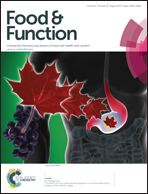Promising new applications of Castanea sativa shell: nutritional composition, antioxidant activity, amino acids and vitamin E profile
Abstract
The present study was aimed to assess the macronutrient composition and the amino acid and vitamin E profiles of Castanea sativa shell from different production regions of Portugal (Minho, Trás-os-Montes and Beira-Alta). The nutritional composition was similar for all samples, with a high moisture content and low fat amounts. Arginine and leucine were the predominant essential amino acids (EAA) accounting for 3.55–7.21% and 1.59–2.08%, respectively, for samples of the different production zones. All the shells presented high contents of vitamin E (481.5 mg per 100 g sample, 962.8 mg per 100 g sample and 567.5 mg per 100 g sample, respectively, for Minho, Trás-os-Montes and Beira-Alta). The predominant vitamer was γ-tocopherol (670 mg per 100 g sample for Trás-os-Montes). The antimicrobial and antioxidant activities of C. sativa shell were also determined. Trás-os-Montes extracts displayed the highest antioxidant activity (EC50 = 31.8 ± 1.3 μg mL−1 for DPPH; 8083.5 ± 164.8 μmol per mg db for FRAP). The total phenolic content (TPC) varied from 241.9 mg to 796.8 mg gallic acid equivalents (GAE) per g db sample, the highest TPC being obtained for Trás-os-Montes. The total flavonoid content (TFC) varied from 31.4 to 43.3 mg of catechin equivalents (CEQ) per g db sample. No antimicrobial activity was observed. The results showed the potentialities of C. sativa shell extracts.


 Please wait while we load your content...
Please wait while we load your content...